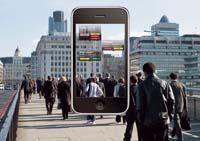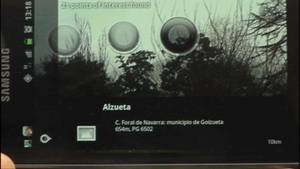Added reality: enriching the perception of the world
2009/12/01 Leturia Azkarate, Igor - Informatikaria eta ikertzailea Iturria: Elhuyar aldizkaria

Virtual reality is a term that we have heard a lot in recent years. This technology consists of showing a simulated reality by computer that interacts with us. That is, we are shown a virtual world that responds to our movements taken through sensors, giving the feeling of the real.
But in recent months the buzzword heard in the world of technology is an added reality (augmented reality). This technology will also teach us a reality with which we can interact, but on this occasion what teaches us is the real world, incorporating information about what we are seeing. This information is obtained from different sources: motion and position sensors, image software processing taken, Internet...
Mobile environment information mobile
The fashion of augmented reality is largely due to the latest generation of mobile phones. They can show on screen what the camcorder takes. But to know the position, orientation and inclination have a GPS, a compass and an accelerometer that allow us to locate what we are seeing geographically. And its growing process capacity allows it to know shapes and objects through techniques such as artificial vision. And having internet connection, you can get a lot of information about what we're seeing. In this way, in recent times, many applications of added reality have been created for these mobile phones.
Perhaps the best known is Layar, an application available on mobile with Android operating system. Aimed at a wide view, we highlight the different museums, restaurants or points of interest in sight, gives us more information about them (schedule, price...) or offers us the possibility to visit their website. There are also real estate applications: they show us which are for sale or for rent of the homes we have in sight, with their prices and the owner's phone.
Among users of image knowledge, applications can be cited that, applying the knowledge of characters (OCR) to the image taken by the camera, will return us a menu or a poster or read us by voice. The Augmented ID program, for its part, uses facial recognition techniques to meet the person we point out with the camera and overlay the information about it. For the moment, just meet those who open an account and upload your photos and information.
There are appearing numerous applications of reality added for use in cars. For example, Wikitude Drive is an application for the mobile phone that fulfills the same function as a GPS navigation system for the car, but that shows the path over the image of the road we see instead of showing it on a map. O Augmented Traffic Views, which can display images of traffic cameras later on the way.
Also in other supports
However, it must be recognized that for some applications it is not appropriate to have the added reality app on the mobile phone. Circular always looking at mobile is not practical, or pointing people with mobile to know who is on the street is very irreverent... But the added reality applies to other media, not just mobile phones.
Lego, for example, has installed in several toy stores cameras and reality gadgets added with screen: Approaching a Lego box, the camera knows it and represents in 3D the model that can be made with the interior pieces and shows it on the screen, moving on the box and with the box. The Casa de los Cromos Topps has carried out an installation program on a normal computer; if we approach a baseball chrome to our website, the program will know it and about the chrome will model the player in 3D making some play. Something similar has been done by Esquire magazine in its December issue: approaching some pages of the magazine to the web, the program will know it and represent the 3D page on the screen.
As for cars, a few years ago some high-end cars project to the windshield the lower panel demonstrators (speed, time, etc. ). This type of systems are called head-up display or HUD. There are also HUD motor helmets. And all this is also an added reality. But lately, more information has been projected: GPS navigation system, night view...
The usual in the future
Augmented reality is still new, but as it spreads, problems will also arise. Spam, that plague of our digital life, runs the risk of coming to real life; let's go to the street if we start displaying advertising on the screen of our added reality... Or privacy can also be a problem: that we go down the street we can know everyone...
However, in the coming years we will surely see more and more powerful applications of added reality, in more and more supports. Let's go to a clothes shop and a "mirror" teaches us how the sweater does not need to dress us; or when we are in the bookstore we pick up a book in hand and see the comments and criticisms of the people projected in the glasses; or by picking up the toy box in the shop, instead of on a screen, we will take in a hologram the 3D model of the interior. Do you want to bet?
Examples of examples are:
What the applications here exposed do is not easy to understand using only verbal explanations. The videos and images that you will find in these links will help you to see better the added reality.
Layar: http://www.bloglines.com/blog/andonisagarna?id=118
A real estate application: http://casasapo.es/News/detail.aspx?id=9422
Image knowledge: http://www.error500.net/eye-phone-realidad-augmented
Wikitude Drive: http://www.genbeta.com/mobile/reality-Increase-in-iphone e-y-android
Augmented Traffic Views: http://www.neoteo.com/augmented-traffic-views-trafico-y-realidad.neo
Augmented ID: http://www.readwriteweb.com/archives/augmented_id_augmented_reality_facial_recognition.php
Lego: http://adland.tv/content/lego-augmented-reality-kiosk-shows-package-contents
Topps cromos: http://www.nytimes.com/2009/03/09/technology/09topps.html?_r=2
Revista Esquire: http://www.genbeta.com/news/ski-video-de-las-paginas-con-reality-augmented
HUD devices: http://www.error500.net/motor/hud-interface -coche-road
In the side mirror of the cars: http://www.xataka.com/gadgets-y-cars/www.euskaltel.com coches-nos-mostraran-mas-information
Reality added in Teknopolis: http://teknopolis.elhuyar.org/ikusi.asp?Multi_Code=337.

Gai honi buruzko eduki gehiago
Elhuyarrek garatutako teknologia






